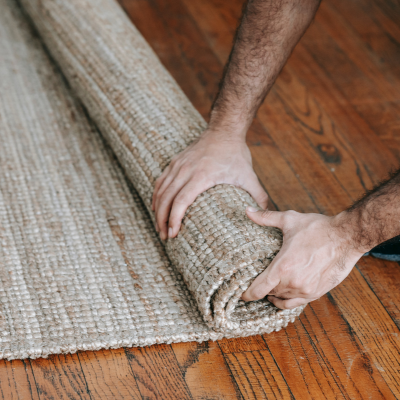Measuring a room for a carpet isn’t the most exciting task in the world, but it’s one that can save you time, money, and a whole lot of stress when it comes to fitting day.
Whether you’re refreshing a tired space or planning a full renovation, getting accurate carpet measurements ensures you buy just the right amount (with a little extra wiggle room for safety). Direct Carpet Centre has seen how much of a difference measuring the room makes on saving costs and times, so let’s break it down.
What You’ll Need Before You Start
Before you break out the tape measure, make sure you’ve got a few essentials on hand.
Essential Tools
-
A tape measure (ideally steel or long enough for full wall spans)
-
Pen and notepad—or your phone’s notes app
-
A calculator
-
Graph paper or a sketch (optional but handy)
Prep the Room
Clear as much space as possible so you can get accurate wall-to-wall measurements. Make note of any:
-
Alcoves or bay windows
-
Doorways and recesses
-
Built-in furniture or irregular edges
Step-by-Step Guide to Measuring a Room
Step 1 – Measure the Length and Width
Start with the basics. Measure the longest length and the widest width of the room in metres or centimetres.
Don’t assume a perfectly rectangular space, take measurements at two points across each wall to be safe.
Step 2 – Include Nooks and Alcoves
Got an awkward corner, alcove, or chimney breast?
Measure that separately and add it to your total. This is especially important if you want the carpet to fit snugly wall-to-wall.
You Might Like: Understanding the Wear Layer in Vinyl Flooring
Step 3 – Add a Fitting Allowance
Always add a little extra. A good rule of thumb is 5–10 cm on each side (roughly 2–4 inches).
This gives your fitter room to trim the edges for a perfect fit and avoids any nasty surprises if your walls aren’t quite square.
Dealing With Unusual Room Shapes
Not every room is a clean rectangle. Here’s how to handle more complicated layouts:
L-Shaped Rooms
Measure the widest and longest point of the room or draw out the L shape and measure the perimeter.
Example:

Curved or Angled Spaces
It’s best to ‘square off’ the space. Measure the maximum width and length that would cover the curve or angle, yes, even if it includes a bit of empty floor. Better to trim than come up short.
You Might Like: The Ultimate Guide to Cleaning and Maintaining Your Vinyl Flooring
Open Plan or Multi-Zone Areas
Treat each zone (like dining and living areas) as separate rectangles.
Take your time and sketch things out if it helps.
How to Calculate Carpet Area
The Simple Formula
All you need is: Length x Width = Area (m²)
For example: A room that’s 4.8m x 3.6m = 17.28m²
Add 10% for trimming and wastage = approx. 19m²
Additional Things to Keep in Mind
There are some additional things to keep in mind before measuring your room for carpet. It’s also worth keeping in mind maintaining and cleaning your carpet after use, which you’ll need some cleaning tools for.
Standard Carpet Roll Widths
Most carpets come in standard widths like 4m or 5m. If your room is wider than this, your fitter may need to join two pieces together, so roll width might influence your final choice.
Seams and Joins
If joins are needed, make sure they’re placed in low-traffic areas or where they’ll be less visible.
Your fitter can usually help plan this in advance.
Don’t Forget Underlay and Gripper Rods
Your new carpet will sit on top of an underlay layer and be secured with gripper rods around the edges.
These don’t usually add much to your measurements, but it’s worth asking your fitter if they recommend adjusting the allowance.
Ready to Buy? What to Do With Your Measurements
Once you’ve measured your room (and double-checked it), you’re good to go. Give your supplier the full dimensions, including any extra allowances. They’ll be able to advise:
-
The best roll width for your space
-
Whether any joins are needed
-
How much carpet to order overall
Tip: Order slightly more than you need. It’s a small cost upfront that could save you a lot later if you ever need repairs or replacement patches.
Final Thoughts
Learning how to measure a room for carpet is easier than it sounds—and it’s well worth the effort. It puts you in control, helps you budget more accurately, and gives your fitter everything they need for a flawless result.
Still unsure or want a second opinion? Our team is happy to help. Get in touch today or visit our homepage to learn more about our carpet options and fitting services.
FAQs
Do I need to move furniture out to measure?
Ideally, yes. It helps you get an accurate wall-to-wall measurement. If not, at least measure around any large items.
Should I measure from the skirting or the wall?
Measure from wall to wall, your fitter will trim to the skirting board for a clean finish.
What if my measurements aren’t exact?
That’s why you add an extra 5–10 cm! Always round up, you can trim carpet, but you can’t stretch it.
Can I just estimate and let the fitter work it out?
You can but you may pay more than you need to, or delay your project. It's always better to come prepared.

